Quantifying the Spatio-Temporal Pattern Differences in Climate Change before and after the Turning Year in Southwest China over the Past 120 Years
Abstract
1. Introduction
2. Materials and Methods
2.1. Overview of the Research Area
2.2. Obtaining and Analyzing the Research Data
2.2.1. Data Sources and Processing
- (1)
- The high-resolution gridded dataset (CRU_TS4. 02) of climate variables used in this study was downloaded from the Institute of Climate Research, University of East An-glia (see Table 1), and its time range covers the period 1901 to 2017 (117 years × 12 months = 1404 months in total) with a resolution of 0.5° × 0.5°. The dataset has been integrated with several well-known databases to re-construct a complete, high-resolution, uninterrupted dataset of surface climate elements [62], and it is often used as a reliable source of climate information when considering the global or regional shaping of climate change and associated environmental impacts [44,59,63]. Moreover, this dataset is consistent with the interannual variability sequence of China’s mean annual temperature and annual precipitation, which can be used to analyze China’s century-long climate change [64]. As SWC spans three terrain zones from west to east, the transition between adjacent zones is scattered (Figure 1a), and the different elevations have significant climatic features (such as elevation-dependent warming [49] and elevation-dependent wetting [50]); meteorological data with a spatial resolution of 0.5° × 0.5° may mask small-scale climate change information. Therefore, in this study, the cubic spline method [65] was used to interpolate climate data with a spatial resolution of 0.5° × 0.5° and enhance the resolution to 0.25° × 0.25°.
- (2)
- The Chinese vegetation zoning data obtained from the Resource and Environmental Science and Data Center reflect the geographical distribution law of Chinese vegetation (see Table 1). Using Arcgis 10.6 software, according to the relevant operation steps (Analysis Tools → Extraction → Clip step), we clipped the vector mapping of the learning area and the vector data consistent with the scope of the learning area were obtained. These mainly included the alpine vegetation area of the tropical monsoon forest and rainforest region, the subtropical evergreen broad-leaved forest region, and the alpine vegetation region of the QX–P, including 13 vegetation zones. The distribution area and location of each vegetation zone were further coordinated and divided into tropical monsoon forest; the east region, northwest region, west-central region, and northwest region of subtropical evergreen broad-leaved forest; and the alpine vegetation region (Figure 1b) [59,60,66].
- (3)
- The 1:1,000,000 Chinese vegetation atlas obtained from the National Specimen Information Infrastructure (see Table 1) was presented in Arcgis10.6 through the Analysis Tools → Extraction → Clip step; vector data consistent with the range of the learning region were obtained by clipping the vector map of the learning region and obtaining 12 vegetation types (Figure 1c) [59,60,66]. The study area is dominated by forest, shrubs, and grassland (Figure 1c); this comprises about 4/5 of the whole area. In the central and eastern parts of SWC, forest vegetation is the dominant vegetation type, and in the western part of SWC, meadows, grasslands, and shrubs are the dominant vegetation types. Alpine vegetation is also predominantly distributed in the western region, with mostly alpine cushion vegetation and alpine sparse vegetation present [67]. The NDVI value of vegetation gradually decreases from southeast to northwest (Figure 1d) (see Table 1).
2.2.2. Research Methods
- (1)
- Simple linear regression: Simple linear regression of the climate factors (temperature and precipitation) was performed using the least-squares method on the pixel scale, where the slope of the simple linear regression equation indicated the strength of the climate factor change [44,50]. The formula for the calculation was as follows:where n is the length of the research period (n = 117 years in this study); is the annual (seasonal) climate factor of the i-th year. When k > 0, the climate shows an increasing trend (warming or humidifying) during the study period; conversely, it shows a decreasing trend (cooling or drying) when k < 0. Moreover, the significance of the climate factor was checked using a t-test.
- (2)
- Piecewise linear regression: Using simple linear regression is suitable for masking long time-series trends. Therefore, piecewise linear regression was used in this study, which can intuitively reflect the changing trends of the time series, and related theoretical studies have been widely applied in various fields [44,56,68]. Linear fitting was performed before and after the turning year, and the optimal solution was the turning year with the smallest sum of the squared residuals of the two segments before and after the turning year [56]. The formula was as follows:where denotes the year, and y corresponds to the climate change factor for different years. Since is the transition year of climate factor change, which cannot fully represent the trend in climate change in the short-term, it is stipulated that 1910 ≤ ≤ 2008, that is, no less than 10 years before and after the transition referring to Wang [56]. , and are regression coefficients, and ε represents the residual error.
3. Results
3.1. Interannual Variation Characteristics of Temperature Factors
3.1.1. Temporal Variation Characteristics of Annual and Seasonal Average Temperatures
3.1.2. Interannual Spatial Variation Characteristics before and after the Turning Year of Annual and Seasonal Average Temperatures
Interannual Spatial Distribution Characteristics of Turning Years of Annual and Seasonal Average Temperatures
Interannual Spatial Difference Characteristics before and after the Turning Years of Annual and Seasonal Average Temperature
3.2. Interannual Variation Characteristics of Precipitation Factors
3.2.1. Temporal Variation Characteristics of Annual and Seasonal Precipitation
3.2.2. Interannual Spatial Variation Characteristics before and after the Turning Year of Annual and Seasonal Precipitation
Interannual Spatial Distribution Characteristics of Turning Years of Annual and Seasonal Precipitation
Interannual Spatial Difference Characteristics before and after the Turning Years of Annual and Seasonal Precipitation
4. Discussion
4.1. Temporal Variation Characteristics of Climate Change
4.2. Spatial Variation Characteristics of Climate Change
4.3. Limitations of the Present Analysis
5. Conclusions
Author Contributions
Funding
Institutional Review Board Statement
Informed Consent Statement
Data Availability Statement
Conflicts of Interest
References
- IPCC. Climate Change 2013: The Physical Science Basis: Summary for Policymakers; Cambridge University Press: Cambridge, UK, 2013. [Google Scholar]
- IPCC. Special Report on Global Warming of 1.5 °C; Cambridge University Press: Cambridge, UK, 2018. [Google Scholar]
- IPCC. Climate Change 2021: The Physical Science Basis. In Contribution of Working Group, I to the Sixth Assessment Report of the Intergovernmental Panel on Climate Change; Cambridge University Press: Cambridge, UK, 2021. [Google Scholar]
- Marotzke, J.; Forster, P.M. Forcing, feedback and internal variability in global temperature trends. Nature 2015, 517, 565–570. [Google Scholar] [CrossRef]
- Xu, Y.Y.; Ramanathan, V.; Victor, D.G. Global warming will happen faster than we think. Nature 2018, 564, 30–32. [Google Scholar] [CrossRef] [PubMed]
- Golledge, N.R.; Keller, E.D.; Gomez, N.; Naughten, K.A.; Bernales, J.; Trusel, L.D.; Edwards, T.L. Global environmental consequences of twenty-first-century ice-sheet melt. Nature 2019, 566, 65–72. [Google Scholar] [CrossRef]
- Yun, X.; Huang, B.Y.; Cheng, J.Y.; Xu, W.H.; Qiao, S.B.; Li, Q.X. A new merge of global surface temperature datasets since the start of 20th century. Earth Syst. Sci. Data 2019, 11, 1629–1643. [Google Scholar] [CrossRef]
- Bell, R.E.; Seroussi, H. History, mass loss, structure, and dynamic behavior of the Antarctic Ice Sheet. Science 2020, 367, 1321–1325. [Google Scholar] [CrossRef]
- China Meteorological Administration. Blue Book on Climate Change in China 2020; Science Press: Beijing, China, 2020. [Google Scholar]
- China Meteorological Administration. Blue Book on Climate Change in China 2022; Science Press: Beijing, China, 2022. [Google Scholar]
- Zhao, W.J. Extreme weather and climate events in China under changing climate. Natl. Sci. Rev. 2020, 7, 938–943. [Google Scholar] [CrossRef]
- IPCC. Emergent risks and key vulnerabilities. In Climate Change 2014: Impacts, Adaptation, and Vulnerability. Part A: Global and Sectoral Aspects. Contribution of Working Group II to the Fifth Assessment Report of the Intergovernmental Panel on Climate Change. Intergovernmental Panel on Climate Change; Field, C.B., Barros, V.R., Dokken, D.J., Mach, K.J., Mastrandrea, M.D., Bilir, T.E., Chatterjee, M., Ebi, K.L., Estrada, Y.O., Genova, R.C., et al., Eds.; Cambridge University Press: Cambridge, UK, 2014. [Google Scholar]
- Morice, C.P.; Kennedy, J.J.; Rayner, N.A.; Winn, J.P.; Hogan, E.; Killick, R.E.; Dunn, R.J.H.; Osborn, T.J.; Jones, P.D.; Simpson, I.R. An updated assessment of near-surface temperature change from 1850: The HadCRUT5 dataset. J. Geophys. Res. Atmos. 2021, 126, e2019JD032361. [Google Scholar] [CrossRef]
- Duan, J.P.; Li, L.; Chen, L.; Zhang, H.X. Time-dependent warming amplification over the Tibetan Plateau during the past few decades. Atmos. Sci. Lett. 2020, 21, e998. [Google Scholar] [CrossRef]
- Feng, S.; Hu, Q.; Huang, W.; Ho, C.H.; Li, R.; Tang, Z. Projected climate regime shift under future global warming from multi-model, multi-scenario CMIP5 simulations. Glob. Planet. Chang. 2014, 112, 41–52. [Google Scholar] [CrossRef]
- Fan, X.W.; Duan, Q.Y.; Shen, C.W.; Wu, Y.; Xing, C. Global surface air temperatures in CMIP6: Historical performance and future changes. Environ. Res. Lett. 2020, 15, 104056. [Google Scholar] [CrossRef]
- Flynn, C.M.; Mauritsen, T. On the climate sensitivity and historical warming evolution in recent coupled model ensembles. Atmos. Chem. Phys. 2020, 20, 7829–7842. [Google Scholar] [CrossRef]
- Gillett, N.P.; Kirchmeier-Young, M.; Ribes, A.; Wu, T.W.; Yukimoto, S.; Ziehn, T. Constraining human contributions to observed warming since the pre-industrial period. Nat. Clim. Chang. 2021, 11, 207–212. [Google Scholar] [CrossRef]
- Zhao, P.; Jones, P.; Cao, L.J.; Yan, Z.W.; Zha, S.Y.; Zhu, Y.N.; Yu, Y.; Tang, G.L. Trend of surface air temperature in eastern China and associated large-scale climate variability over the last 100 years. J. Clim. 2014, 27, 4693–4703. [Google Scholar] [CrossRef]
- Wang, J.F.; Xu, C.D.; Hu, M.G.; Li, Q.X.; Yan, Z.W.; Jones, P. Global land surface air temperature dynamics since 1880. Int. J. Climatol. 2018, 38, e466–e474. [Google Scholar] [CrossRef]
- Zhou, C.; Wang, K. Land surface temperature over global deserts: Means, variability, and trends. J. Geophys. Res. Atmos. 2016, 121, 14344–14357. [Google Scholar] [CrossRef]
- Retamales-Muñoz, G.; Durán-Alarcón, C.; Mattar, C. Recent land surface temperature patterns in Antarctica using satellite and reanalysis data. J. South. Am. Earth. Sci. 2019, 95, 102304. [Google Scholar] [CrossRef]
- Liu, J.; Hagan, F.T.; Liu, Y. Global Land Surface Temperature Change (2003–2017) and Its Relationship with Climate Drivers: AIRS, MODIS, and ERA5-Land Based Analysis. Remote Sens. 2021, 13, 44. [Google Scholar] [CrossRef]
- Li, B.F.; Chen, Y.N.; Shi, X. Does elevation dependent warming exist in high mountain Asia? Environ. Res. Lett. 2020, 15, 024012. [Google Scholar] [CrossRef]
- Jaber, S.M.; Abu-Allaban, M.M. TRMM 3B43 Product-Based Spatial and Temporal Anatomy of Precipitation Trends: Global Perspective. Environ. Monit. Assess. 2020, 192, 437. [Google Scholar] [CrossRef]
- Zeng, Z.; Li, Y.; Wu, W.; Zhou, Y.; Wang, X.; Huang, H.; Li, Z. Spatio-Temporal Variation of Drought within the Vegetation Growing Season in North Hemisphere (1982–2015). Water 2020, 12, 2146. [Google Scholar] [CrossRef]
- Dai, A. Hydroclimatic trends during 1950–2018 over global land. Clim. Dyn. 2021, 56, 4027–4049. [Google Scholar] [CrossRef]
- Nguyen, P.; Thorstensen, A.; Sorooshian, S.; Hsu, K.; Aghakouchak, A.; Ashouri, H.; Tran, H.; Braithwaite, D. Global precipitation trends across spatial scales using satellite observations. Bull. Am. Meteorol. Soc. 2018, 99, 689–697. [Google Scholar] [CrossRef]
- Greve, P.; Orlowsky, B.; Mueller, B.; Sheffield, J.; Reichstein, M.; Seneviratne, S.I. Global assessment of trends in wetting and drying over land. Nat. Geosci. 2014, 7, 716–721. [Google Scholar] [CrossRef]
- Vicente-Serrano, S.M.; Quiring, S.; Peña-Gallardo, M.; Domínguez-castro, F.; Yuan, S. A review of environmental droughts: Increased risk under global warming? Earth. Sci. Rev. 2020, 201, 102953. [Google Scholar] [CrossRef]
- Yan, Z.W.; Ding, Y.H.; Zhai, P.M.; Song, L.C.; Cao, L.J.; Li, Z. Re-assessing climatic warming in China since the last century. Acta Meteor. Sinica 2020, 78, 370–378. (In Chinese) [Google Scholar]
- Jin, K.; Wang, F.; Yu, Q.; Gou, J.J.; Liu, H.H. Varied degrees of urbanization effects on observed surface air temperature trends in China. Clim. Res. 2018, 76, 131–143. [Google Scholar] [CrossRef]
- Cao, L.; Zhu, Y.; Tang, G.; Yuan, F.; Yan, Z. Climatic warming in China according to a homogenized data set from 2419 stations. Int. J. Climatol. 2016, 36, 4384–4392. [Google Scholar] [CrossRef]
- Piao, S.L.; Ciais, P.; Huang, Y.; Yu, Y.Q.; Zhang, T.Y.; Fang, J.Y. The impacts of climate change on water resources and agriculture in China. Nature 2010, 467, 43–51. [Google Scholar] [CrossRef]
- Ding, Y.H. Climate Change and Prediction in China; China Meteorological Press: Beijing, China, 2016. (In Chinese) [Google Scholar]
- Tan, X.; Wu, Y.; Liu, B.; Chen, S. Inconsistent changes in global precipitation seasonality in seven precipitation datasets. Clim. Dyn. 2020, 54, 3091–3108. [Google Scholar] [CrossRef]
- Ma, S.M.; Zhou, T.J.; Dai, A.G.; Han, Z.Y. Observed changes in the distributions of daily precipitation frequency and amount over China from 1960 to 2013. J. Clim. 2015, 28, 6960–6978. [Google Scholar] [CrossRef]
- Köppen, W. Die Wärmezonen der Erde, nach der Dauer der heissen, gemässigten, und kalten Zeitund nach der Wirkung der Wärme auf die organische Welt betrachtet. Meteorol. Z. 1884, 1, 215–226. [Google Scholar]
- Guan, Y.L.; Lu, H.W.; Yin, C.; Xue, Y.X.; Jiang, Y.L.; Kang, Y.; He, L.; Heiskanen, J. Vegetation response to climate zone dynamics and its impacts on surface soil water content and albedo in China. Sci. Total. Environ. 2020, 747, 141537. [Google Scholar] [CrossRef] [PubMed]
- Guan, Y.L.; Lu, H.W.; He, L.; Adhikari, H.; Pellikka, P.; Maeda, E.; Heiskanen, J. Intensification of the dispersion of the global climatic landscape and its potential as a new climate change indicator. Environ. Res. Lett. 2020, 15, 114032. [Google Scholar] [CrossRef]
- Beck, H.E.; Zimmermann, N.E.; McVicar, T.R.; Vergopolan, N.; Berg, A.; Wood, E.F. Present and future Köppen-Geiger climate classification maps at 1-km resolution. Sci. Data 2018, 5, 180214. [Google Scholar] [CrossRef] [PubMed]
- Garcia, R.A.; Cabeza, M.; Rahbek, C.; Araújo, M.B. Multiple dimensions of climate change and their implications for biodiversity. Science 2014, 344, 1247579. [Google Scholar] [CrossRef]
- Chan, D.; Wu, Q. Significant anthropogenic-induced changes of climate classes since 1950. Sci. Rep. 2015, 5, 13487. [Google Scholar] [CrossRef] [PubMed]
- Wang, M.; Jiang, C.; Sun, O.J. Spatially differentiated changes in regional climate and underlying drivers in southwestern China. J. For. Res. 2022, 33, 755–765. [Google Scholar] [CrossRef]
- Zeng, Z.Z.; Piao, S.L.; Li, L.Z.X.; Zhou, L.M.; Ciais, P.; Wang, T.; Li, Y.; Lian, X.; Wood, E.F.; Friedlingstein, P.; et al. Climate mitigation from vegetation biophysical feedbacks during the past three decades. Nat. Clim. Chang. 2017, 7, 432–436. [Google Scholar] [CrossRef]
- Alkama, R.; Cescatti, A. Climate change: Biophysical climate impacts of recent changes in global forest cover. Science 2016, 351, 600–604. [Google Scholar] [CrossRef]
- Huang, B.; Hu, X.P.; Fuglstad, G.A.; Zhou, X.; Zhao, W.W.; Cherubini, F. Predominant regional biophysical cooling from recent land cover changes in Europe. Nat. Commun. 2020, 11, 1066. [Google Scholar] [CrossRef]
- Peng, S.S.; Piao, S.L.; Zeng, Z.Z.; Ciais, P.; Zhou, L.M.; Li, L.Z.X.; Myneni, R.B.; Yin, Y.; Zeng, H. Afforestation in China cools local land surface temperature. Proc. Natl. Acad. Sci. USA 2014, 111, 2915–2919. [Google Scholar] [CrossRef] [PubMed]
- Pepin, N.; Bradley, R.S.; Diaz, H.F.; Baraer, M.; Caceres, E.B.; Forsythe, N.; Fowler, H.; Greenwood, G.; Hashmi, M.Z.; Liu, X.D.; et al. Elevation-dependent warming in mountain regions of the world. Nat. Clim. Chang. 2015, 5, 424–430. [Google Scholar]
- Li, X.P.; Wang, L.; Guo, X.Y.; Chen, D.L. Does summer precipitation trend over and around the Tibetan Plateau depend on elevation? Int. J. Climatol. 2017, 37, 1278–1284. [Google Scholar] [CrossRef]
- Aguilar-Lome, J.; Espinoza-Villar, R.; Espinoza, J.C.; Rojas-Acuña, J.; Willems, B.L.; Leyva-Molina, W.M. Elevation-dependent warming of land surface temperatures in the Andes assessed using MODIS LST time series (2000–2017). Int. J. Appl. Earth. Obs. 2019, 77, 119–128. [Google Scholar] [CrossRef]
- Fan, Z.X.; Bräuning, A.; Thomas, A.; Li, J.B.; Cao, K.F. Spatial and temporal temperature trends on the Yunnan Plateau (Southwest China) during 1961–2004. Int. J. Climatol. 2011, 31, 2078–2090. [Google Scholar] [CrossRef]
- Palazzi, E.; Mortarini, L.; Terzago, S.; von Hardenberg, J. Elevation-dependent warming in global climate model simulations at high spatial resolution. Clim. Dyn. 2019, 52, 2685–2702. [Google Scholar] [CrossRef]
- Kang, S.C.; Xu, Y.W.; You, Q.L.; Flugel, W.A.; Pepin, N.; Yao, T.D. Review of climate and cryospheric change in the Tibetan Plateau. Environ. Res. Lett. 2010, 5, 015101. [Google Scholar] [CrossRef]
- Guo, D.; Sun, J.; Yang, K.; Pepin, N.; Xu, Y. Revisiting Recent Elevation-Dependent Warming on the Tibetan Plateau Using Satellite-Based Data Sets. J. Geophys. Res. Atmos. 2019, 124, 8511–8521. [Google Scholar] [CrossRef]
- Wang, S.P.; Wang, Z.H.; Piao, S.L.; Fang, J.Y. Regional differences in the timing of recent air warming during the past four decades in China. Chin. Sci. Bull. 2010, 55, 1968–1973. [Google Scholar] [CrossRef]
- Li, X.C. Historical Geography: Geopolitics, Regional Economy and Culture; Peking University Press: Beijing, China, 2004; pp. 79–93. (In Chinese) [Google Scholar]
- You, Q.; Chen, D.; Wu, F.; Pepin, N.; Cai, Z.; Ahrens, B.; Jiang, Z.; Wu, Z.; Kang, S.; Amir, A.K. Elevation dependent warming over the Tibetan Plateau: Patterns, mechanisms and perspectives. Earth-Sci. Rev. 2020, 210, 103349. [Google Scholar] [CrossRef]
- Wang, M.; An, Z. Regional and Phased Vegetation Responses to Climate Change Are Different in Southwest China. Land 2022, 11, 1179. [Google Scholar] [CrossRef]
- Wang, M.; An, Z.; Wang, S. The Time Lag Effect Improves Prediction of the Effects of Climate Change on Vegetation Growth in Southwest China. Remote Sens. 2022, 14, 5580. [Google Scholar] [CrossRef]
- Li, M.L.; Yin, L.C.; Zhang, Y.; Su, X.K.; Liu, G.H.; Wang, X.F.; Au, Y.; Wu, X. Spatio-temporal dynamics of fractional vegetation coverage based on MODIS-EVI and its driving factors in Southwest China. Acta Ecol. Sin. 2021, 41, 1138–1147. (In Chinese) [Google Scholar]
- Harris, I.; Osborn, T.; Jones, P.; Lister, D. Version 4 of the CRU TS monthly high-resolution gridded multivariate climate da-taset. Sci. Data 2020, 7, 109 . [Google Scholar] [CrossRef]
- Buermann, W.G.; Forkel, M.; O’Sullivan, M.; Sitch, S.; Friedlingstein, P.; Haverd, V. Widespread seasonal compensation effects of spring warming on northern plant productivity. Nature 2018, 562, 110–115. [Google Scholar] [CrossRef]
- Wen, X.; Wang, S.; Zhu, J.; David, V. An Overview of China Climate Change over the 20th Century Using UK UEA/CRU High Resolution Grid Data. Chin. J. Atmos. Sci. 2006, 30, 894–904. (In Chinese) [Google Scholar]
- Knott, G.D. Interpolating Cubic Splines; Springer Science & Business Media: Berlin, Germany, 2012; pp. 1–244. [Google Scholar]
- Wang, M.; An, Z. Quantifying the Interaction Effects of Climatic Factors on Vegetation Growth in Southwest China. Remote Sens. 2023, 15, 774. [Google Scholar] [CrossRef]
- Xiong, Q.L.; He, Y.L.; Deng, F.Y.; Li, T.Y.; Yu, L. Assessment of alpine mean response to climate change in Southwest China based on MaxEnt model. Acta Ecol. Sin. 2019, 39, 9033–9043. (In Chinese) [Google Scholar]
- Wang, X.H.; Piao, S.L.; Ciais, P.; Li, J.S.; Friedlingstein, P.; Koven, C.D.; Chen, A.P. Spring temperature change and its implication in the change of vegetation growth in North America from 1982 to 2006. Proc. Natl. Acad. Sci. USA 2011, 108, 1240–1245. [Google Scholar] [CrossRef]
- Smith, T.M.; Reynolds, R.W.; Peterson, T.C.; Lawrimore, J. Improvements to NOAA’s historical merged land-ocean surface temperature analysis (1880–2006). J. Clim. 2008, 21, 2283–2296. [Google Scholar] [CrossRef]
- Zhu, X.; Dong, W.; Wei, Z.; Guo, Y.; Gao, X.; Wen, X.; Yang, S.; Zheng, Z.; Yan, D.; Zhu, Y.; et al. Multi-decadal evolution characteristics of global surface temperature anomaly data shown by observation and CMIP5 models. Int. J. Climatol. 2017, 38, 1533–1542. [Google Scholar] [CrossRef]
- Kosaka, Y.; Xie, S. Recent global-warming hiatus tied to equatorial pacific surface cooling. Nature 2013, 501, 403–407. [Google Scholar] [CrossRef] [PubMed]
- Cai, Y.; Li, D.L.; Tang, M.C.; Bai, C.Y. Decadal temperature changes over Qinghai-Xizang plateau in recent 50 years. Plateau Meteorol. 2003, 22, 464–470, (In Chinese with English abstract). [Google Scholar]
- Liu, X.; Chen, B. Climatic warming in the tibetan plateau during recent decades. Int. J. Climatol. 2000, 20, 1729–1742. [Google Scholar] [CrossRef]
- Wang, H.; Liu, H.; Cao, G.; Sanders, N.J.; Classen, A.T.; He, J.S. Alpine grassland plants grow earlier and faster but biomass remains unchanged over 35 years of climate change. Ecol. Lett. 2020, 23, 701–710. [Google Scholar] [CrossRef]
- Li, L.; Chen, X.G.; Wang, Z.Y.; Xu, W.X.; Tang, H.Y. Climate change and its regional differences over the tibetan plateau. Adv. Clim. Chang. Res. 2010, 6, 181–186, (In Chinese with English abstract). [Google Scholar]
- Oguntunde, P.G.; Abiodun, B.J.; Lischeid, G. Rainfall trends in Nigeria, 1901–2000. J. Hydrol. 2011, 411, 207–218. [Google Scholar] [CrossRef]
- Li, Y.P.; Chen, Y.N.; Li, Z. Dry/wet pattern changes in global dryland areas over the past six decades. Glob. Planet. Chang. 2019, 178, 184–192. [Google Scholar] [CrossRef]
- Sun, W.B.; Li, Q.X.; Huang, B.Y.; Cheng, J.Y.; Song, Z.Y.; Li, H.Y.; Dong, W.J.; Zhai, P.M.; Jones, P.D. The Assessment of Global Surface Temperature Change from 1850s: The C-LSAT2.0 Ensemble and the CMST-Interim Datasets. Adv. Atmos. Sci. 2021, 38, 875–888. [Google Scholar] [CrossRef]
- Roderick, M.L.; Sun, F.; Lim, W.H.; Farquhar, G.D. A general framework for understanding the response of the water cycle to global warming over land and ocean Hydrol. Earth Syst. Sci. 2014, 18, 1575–1589. [Google Scholar] [CrossRef]
- Bonan, G.B. Forests and climate change: Forcings, feedbacks, and the climate benefits of forests. Science 2008, 320, 1444–1449. [Google Scholar] [CrossRef]
- Yang, K.; Ye, B.S.; Zhou, D.G.; Wu, B.Y.; Foken, T.; Qin, J.; Zhou, Z.Y. Response of hydrological cycle to recent climate changes in the Tibetan Plateau. Clim. Chang. 2011, 109, 517–534. [Google Scholar] [CrossRef]
- Dong, N.; Xu, X.D.; Cai, W.Y.; Zhao, T.L.; Sun, C. Comprehensive effects of interdecadal change of sea surface temperature increase in the Indo-Pacific Ocean on the warming-wetting of the Qinghai–Tibet Plateau. Sci. Rep. 2022, 12, 22306. [Google Scholar] [CrossRef] [PubMed]
- Ren, Q.; Zhou, C.Y.; He, J.H.; Cen, S.X.; Deng, M.Y. Impact of preceding Indian Ocean Sea surface temperature anomaly on water vapor content over the Tibetan Plateau moist pool in summer and its possible reason. Chin. J. Atmos. Sci. 2017, 41, 648–658. [Google Scholar]
- Tang, J.; Guo, X.L.; Chang, Y.; Lu, G.X.; Qi, P. Temporospatial distribution and trends of thunderstorm, hail, gale, and heavy precipitation events over the Tibetan Plateau and associated mechanisms. J. Clim. 2021, 34, 9623–9646. [Google Scholar] [CrossRef]
- Li, L.; Zhang, R.H.; Wen, M.; Lv, J.M. Regionally different precipitation trends over the Tibetan Plateau in the warming context: A perspective of the Tibetan Plateau vortices. J. Geophys. Res. 2021, 48, 1680. [Google Scholar] [CrossRef]
- Yao, T.; Thompson, L.; Yang, W.; Xiang, Y.; Kattel, D.B.; Joswiak, D. Different glacier status with atmospheric circulations in Tibetan Plateau and surroundings. Nat. Clim. Chang. 2012, 2, 663–667. [Google Scholar] [CrossRef]
- Zhao, H.; Xu, B.; Yao, T.; Wu, G.; Lin, S.; Gao, J.; Wang, M. Deuterium excess record in a southern Tibetan ice core and its potential climatic implications. Clim. Dynam. 2012, 38, 1791–1803. [Google Scholar] [CrossRef]
- Norris, J.; Carvalho, L.M.V.; Jones, C.; Cannon, F. Warming and drying over the central Himalaya caused by an amplification of local mountain circulation. Npj Clim. Atmos. Sci. 2020, 3, 1. [Google Scholar] [CrossRef]
- Sun, J.; Yang, K.; Guo, W.D.; Wang, Y.; He, J.; Lu, H. Why has the Inner Tibetan Plateau become wetter since the mid-1990s? J. Clim. 2020, 33, 8507–8522. [Google Scholar] [CrossRef]
- Zhang, C.; Tang, Q.; Chen, D. Recent changes in the moisture source of precipitation over the Tibetan Plateau. J. Clim. 2017, 30, 1807–1819. [Google Scholar] [CrossRef]
- Curio, J.; Maussion, F.; Scherer, D. A 12-year high-resolution climatology of atmospheric water transport over the Tibetan Plateau. Earth Syst. Dyn. 2015, 6, 109–124. [Google Scholar] [CrossRef]
- Yao, J.Q.; Yang, Q.; Mao, W.Y.; Zhao, Y.; Xu, X.B. Precipitation trend–Elevation relationship in arid regions of the China. Glob. Planet. Chang. 2016, 143, 1–9. [Google Scholar] [CrossRef]
- Tu, J.; Lu, E. Relative importance of water vapor and air temperature in the interannual variation of the seasonal precipitation: A comparison of the physical and statistical methods. Clim. Dyn. 2020, 54, 3655–3670. [Google Scholar] [CrossRef]
- Ding, Y.H.; Sun, Y.; Wang, Z.Y.; Song, Y.F. Inter-decadal variation of the summer precipitation in China and its association with decreasing Asian summer monsoon Part II: Possible causes. Int. J. Climatol. 2009, 29, 1926–1944. [Google Scholar] [CrossRef]
- Hu, Y.; Xu, J.; Huang, C.; Zhou, Y.; Pang, Y.; Shi, Z.; Chen, X. Spatial and Temporal Variations in the Rainy Season Onset over the Qinghai–Tibet Plateau. Water 2019, 11, 1960. [Google Scholar] [CrossRef]
- Liu, Z.; Yang, M.; Wan, G.; Wang, X. The Spatial and Temporal Variation of Temperature in the Qinghai-Xizang (Tibetan) Plateau during 1971–2015. Atmosphere 2017, 8, 214. [Google Scholar] [CrossRef]
- Wang, S.J. Spatiotemporal variability of temperature trends on the southeast Tibetan Plateau, China. Int. J. Climatol. 2018, 38, 11953–11963. [Google Scholar] [CrossRef]
- Chen, L.X.; Song, Y.K.; Liu, J.P.; Wang, W. On the diurnal variation of convection over Qinghai-Xizang Plateau during summer as revealed from meteorological satellite data. Acta Meteorol. Sin. 1999, 57, 549–560. [Google Scholar]
- Xu, X.K. Spatiotemporal variation of total cloud and low cloud over China. Meteorol. Mon. 2012, 38, 90–95. [Google Scholar]
- Shen, M.G.; Piao, S.L.; Jeong, S.J.; Zhang, G.X.; Zhang, Y.J.; Yao, T.D. Evaporative cooling over the Tibetan Plateau induced by vegetation growth. Proc. Natl. Acad. Sci. USA 2015, 112, 9299–9304. [Google Scholar] [CrossRef] [PubMed]
- Pei, J.; Niu, Z.; Wang, L.; Huang, N.; Cao, J.H. Quantifying the Spatio-Temporal Variations and Impact Factors for Vegetation Coverage in the Karst Regions of Southwest China Using Landsat Data and Google Earth Engine. In Proceedings of the Conference on Multispectral, Hyperspectral, and Ultraspectral Remote Sensing Technology, Techniques, and Applications, Honolulu, HI, USA, 23 October 2018. [Google Scholar]
- Jackson, R.B.; Randerson, J.T.; Anderson, R.G.; Avissar, R.; Baldocchi, D.D.; Bonan, G.B.; Caldeira, K.; Diffenbaugh, N.S.; Field, C.B.; Hungate, B.A.; et al. Protecting climate with forests. Enuiron. Res. Lett. 2008, 3, 044006. [Google Scholar] [CrossRef]
- Chen, S.; Zhang, R.; Mao, R.; Zhang, Y.; Chen, Y.; Ji, Z.; Gong, Y.; Guan, Y. Sources, characteristics and climate impact of light-absorbing aerosols over the Tibetan Plateau. Earth-Sci. Rev. 2022, 232, 104111. [Google Scholar] [CrossRef]
- Zhang, R.; Zhou, S. The air temperature change over the Tibetan Plateau during 1979–2002 and its possible linkage with ozone depletion. Acta Meteor. Sin. 2008, 6, 916–925. [Google Scholar]
- Yang, X.; Hou, Y.; Chen, B. Observed surface warming induced by urbanization in east China. J. Geophys. Res. 2011, 116, D14113. [Google Scholar] [CrossRef]
- Duan, A.; Xiao, Z.; Wu, G. Characteristics of climate change over the Tibet Plateau under the global warming during 1979–2014. Clim. Chang. Res. 2016, 12, 374–381. [Google Scholar]
- Wang, M.; Wang, H.S.; Jiang, C.; Sun, J.X. Spatial soil erosion patterns and quantitative attribution analysis in Southwestern China based on RUSLE and Geo-Detector model. J. Basic Sci. Eng. 2021, 29, 1386–1402, (In Chinese with English abstract). [Google Scholar]
- Bao, X.; Zhang, F. How accurate are modern atmospheric reanalysis for the data-sparse Tibetan Plateau region. J. Clim. 2019, 32, 7153–7172. [Google Scholar] [CrossRef]
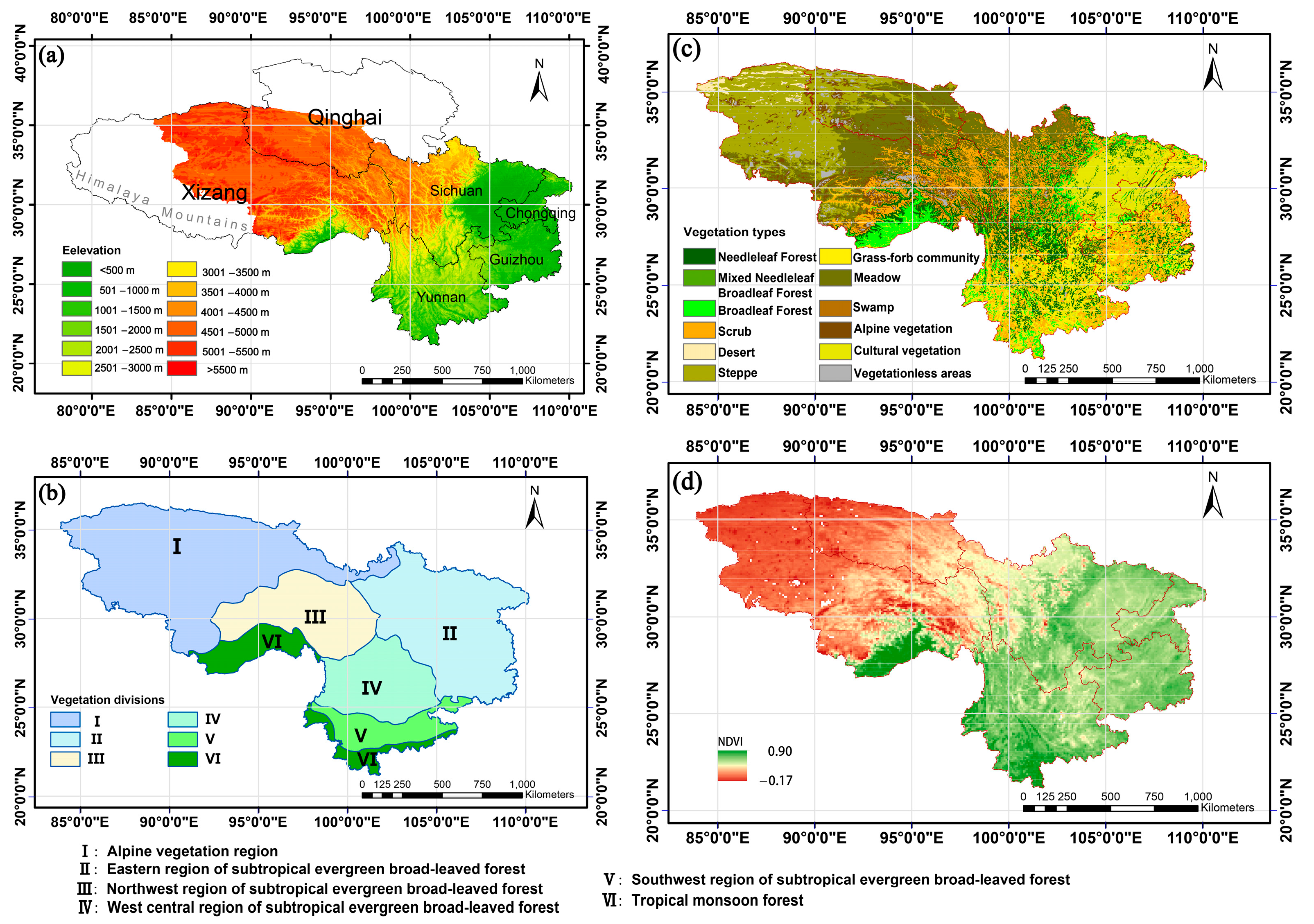
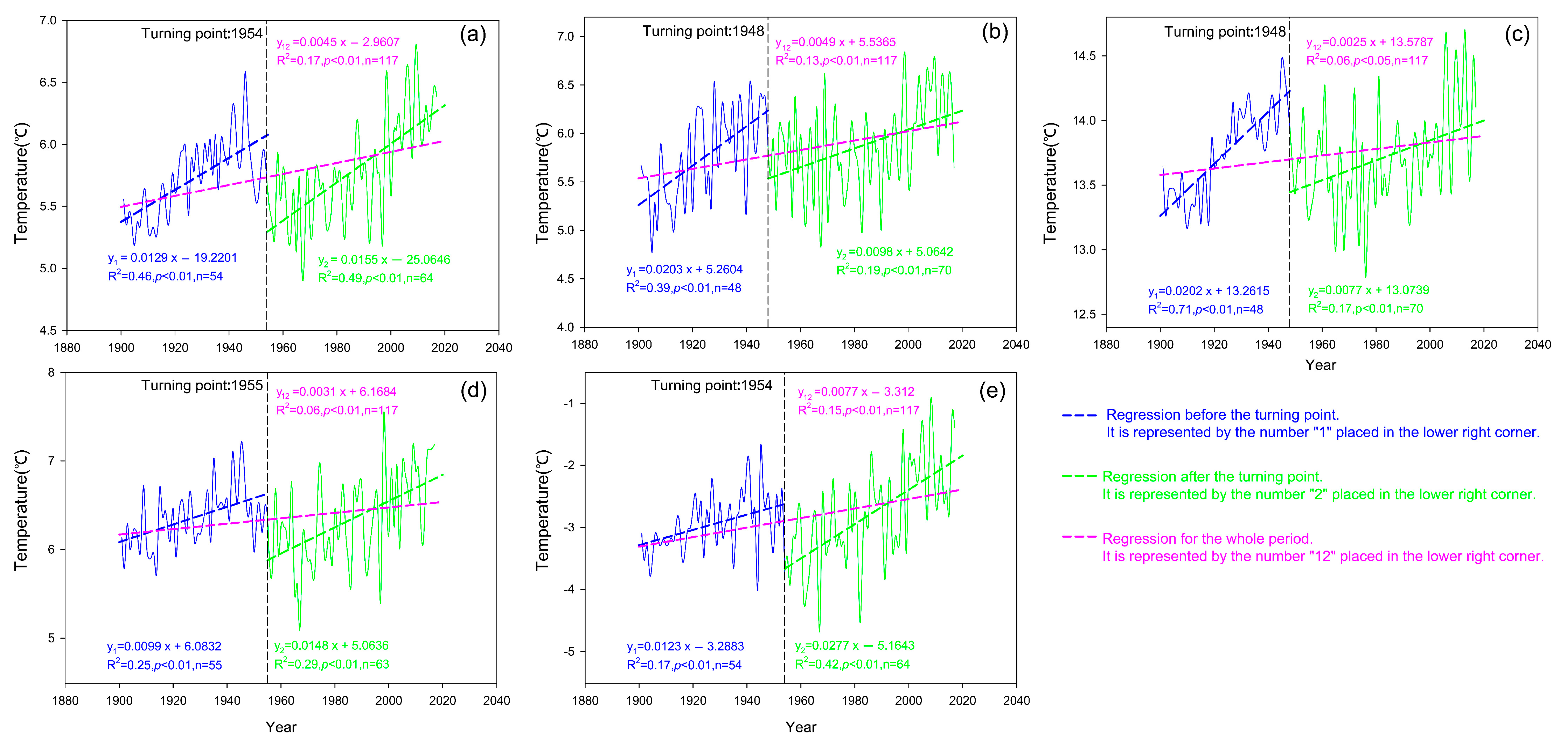
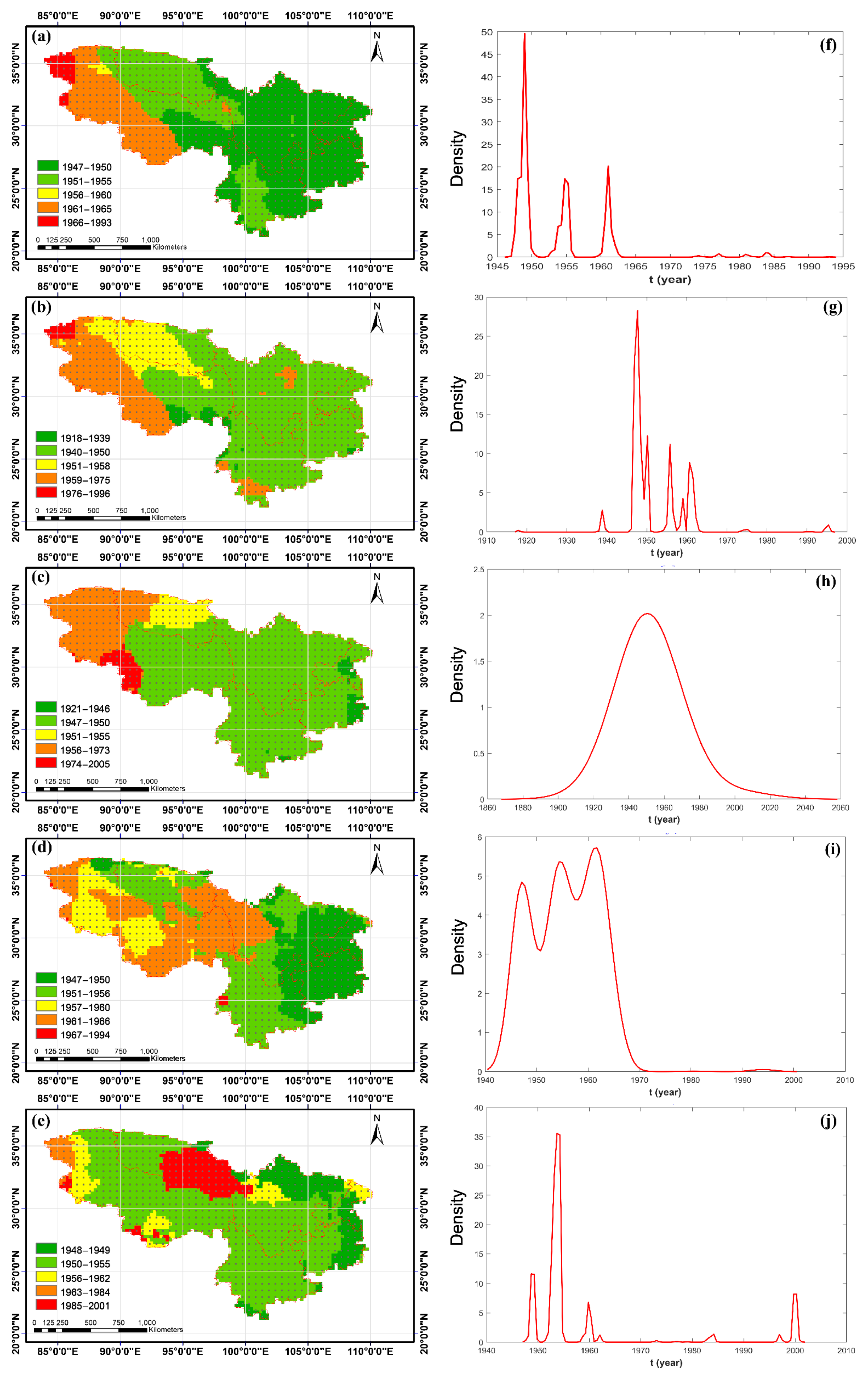
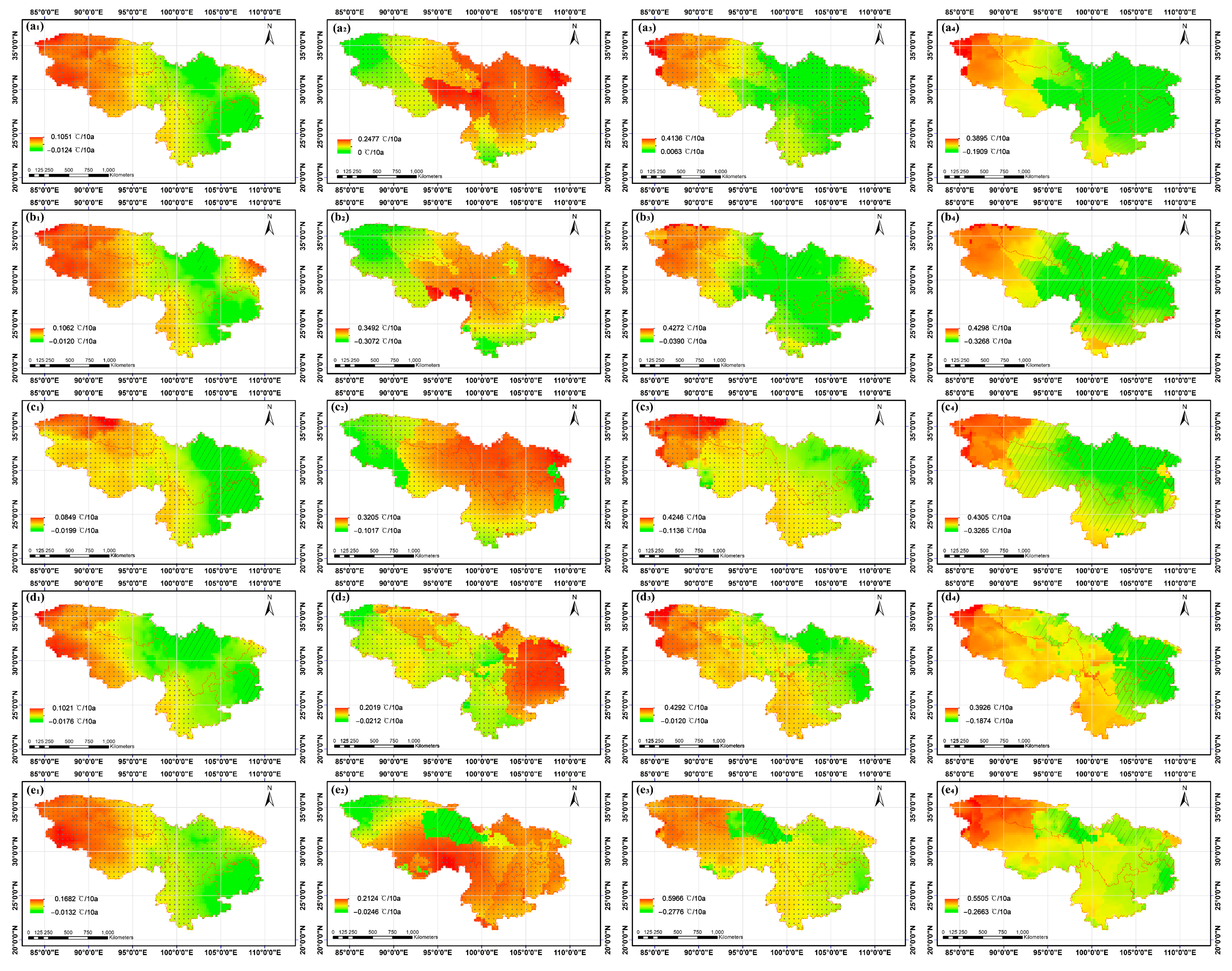
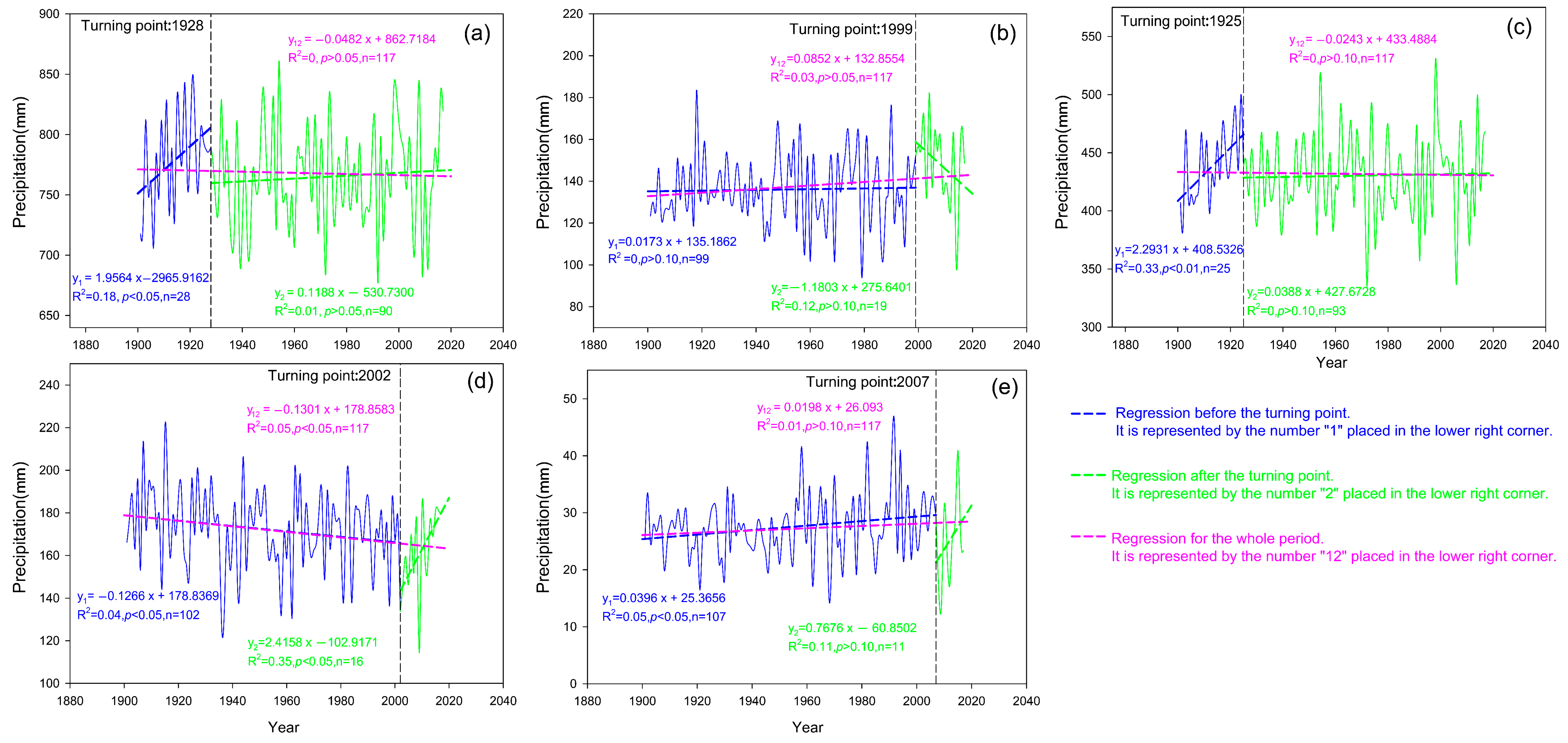

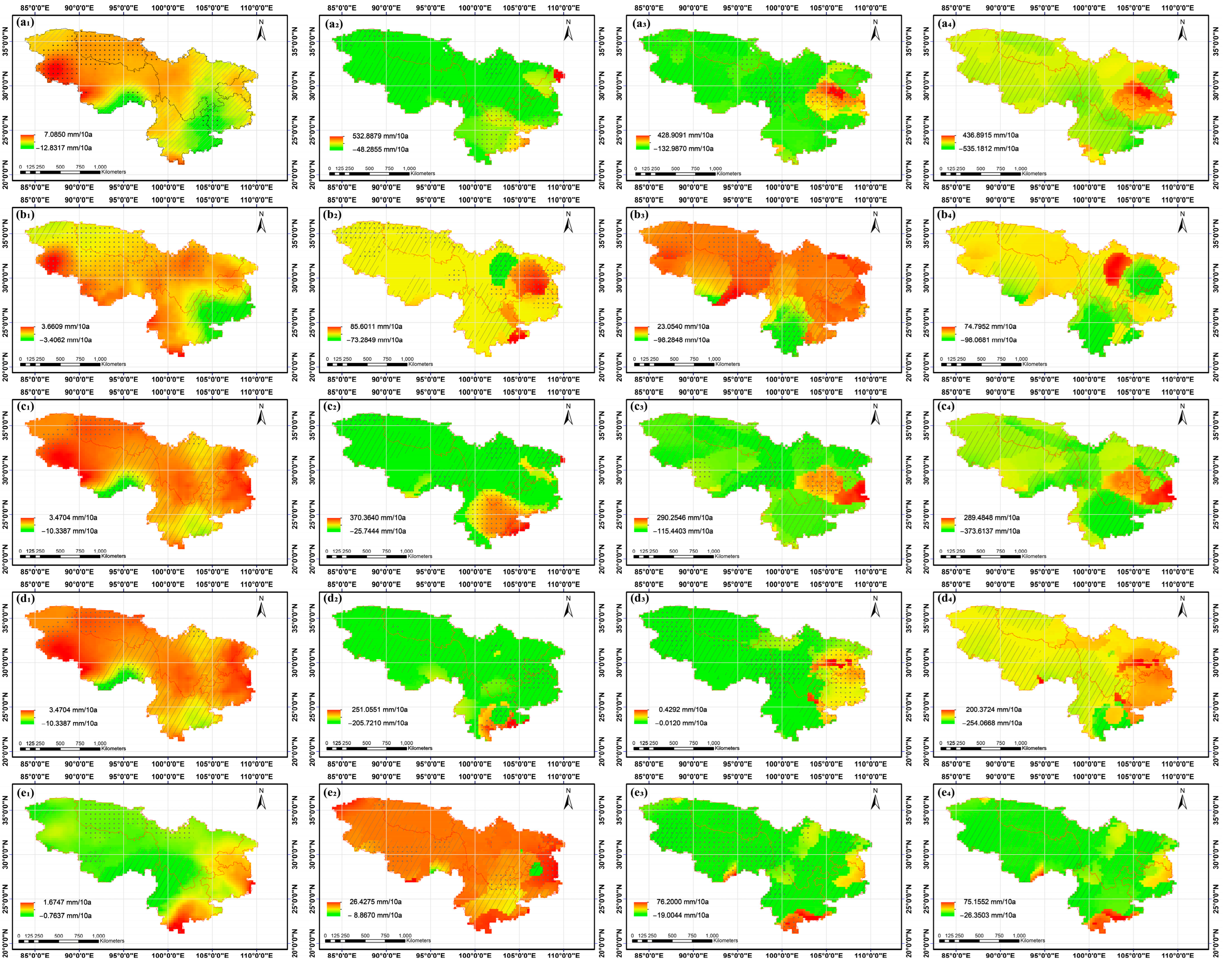
| Name | Sources | Resolution | Web Links | Access Date | Format |
|---|---|---|---|---|---|
| Digital elevation model | Resource and Environment Science and Data Center | 1 × 1 km | https://www.resdc.cn/data.aspx?DATAID=123 | 28 September 2019 | GRID |
| 1:1 million vegetation map of China | Resource and Environment Science and Data Center | — | https://www.resdc.cn/data.aspx?DATAID=122 | 1 December 2017 | .shp |
| China’s vegetation zoning data | Resource and Environment Science and Data Center | — | http://www.resdc.cn/data.aspx?DATAID=133 | 1 December 2017 | .shp |
| GIMMS NDVI3g | GIMMS | 8 × 8 km | https://ecocast.arc.nasa.gov/data/pub/GIMMS/ | 18 November 2018 | .nc4 |
| CRU_TS4.02 | Climate Research Unit | 0.5° × 0.5° | https://crudata.uea.ac.uk/cru/data/hrg/ | 28 June 2019 | .nc |
Disclaimer/Publisher’s Note: The statements, opinions and data contained in all publications are solely those of the individual author(s) and contributor(s) and not of MDPI and/or the editor(s). MDPI and/or the editor(s) disclaim responsibility for any injury to people or property resulting from any ideas, methods, instructions or products referred to in the content. |
© 2023 by the authors. Licensee MDPI, Basel, Switzerland. This article is an open access article distributed under the terms and conditions of the Creative Commons Attribution (CC BY) license (https://creativecommons.org/licenses/by/4.0/).
Share and Cite
Wang, M.; Wang, S.; An, Z. Quantifying the Spatio-Temporal Pattern Differences in Climate Change before and after the Turning Year in Southwest China over the Past 120 Years. Atmosphere 2023, 14, 940. https://doi.org/10.3390/atmos14060940
Wang M, Wang S, An Z. Quantifying the Spatio-Temporal Pattern Differences in Climate Change before and after the Turning Year in Southwest China over the Past 120 Years. Atmosphere. 2023; 14(6):940. https://doi.org/10.3390/atmos14060940
Chicago/Turabian StyleWang, Meng, Shouyan Wang, and Zhengfeng An. 2023. "Quantifying the Spatio-Temporal Pattern Differences in Climate Change before and after the Turning Year in Southwest China over the Past 120 Years" Atmosphere 14, no. 6: 940. https://doi.org/10.3390/atmos14060940
APA StyleWang, M., Wang, S., & An, Z. (2023). Quantifying the Spatio-Temporal Pattern Differences in Climate Change before and after the Turning Year in Southwest China over the Past 120 Years. Atmosphere, 14(6), 940. https://doi.org/10.3390/atmos14060940








